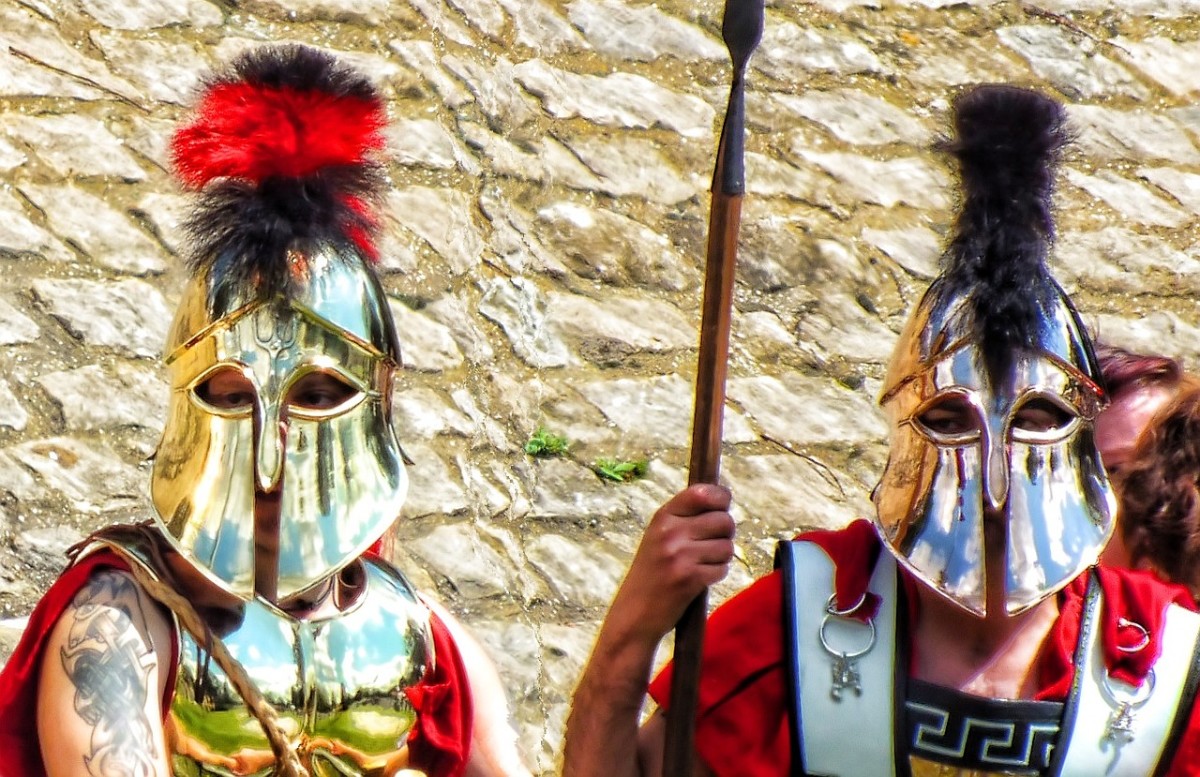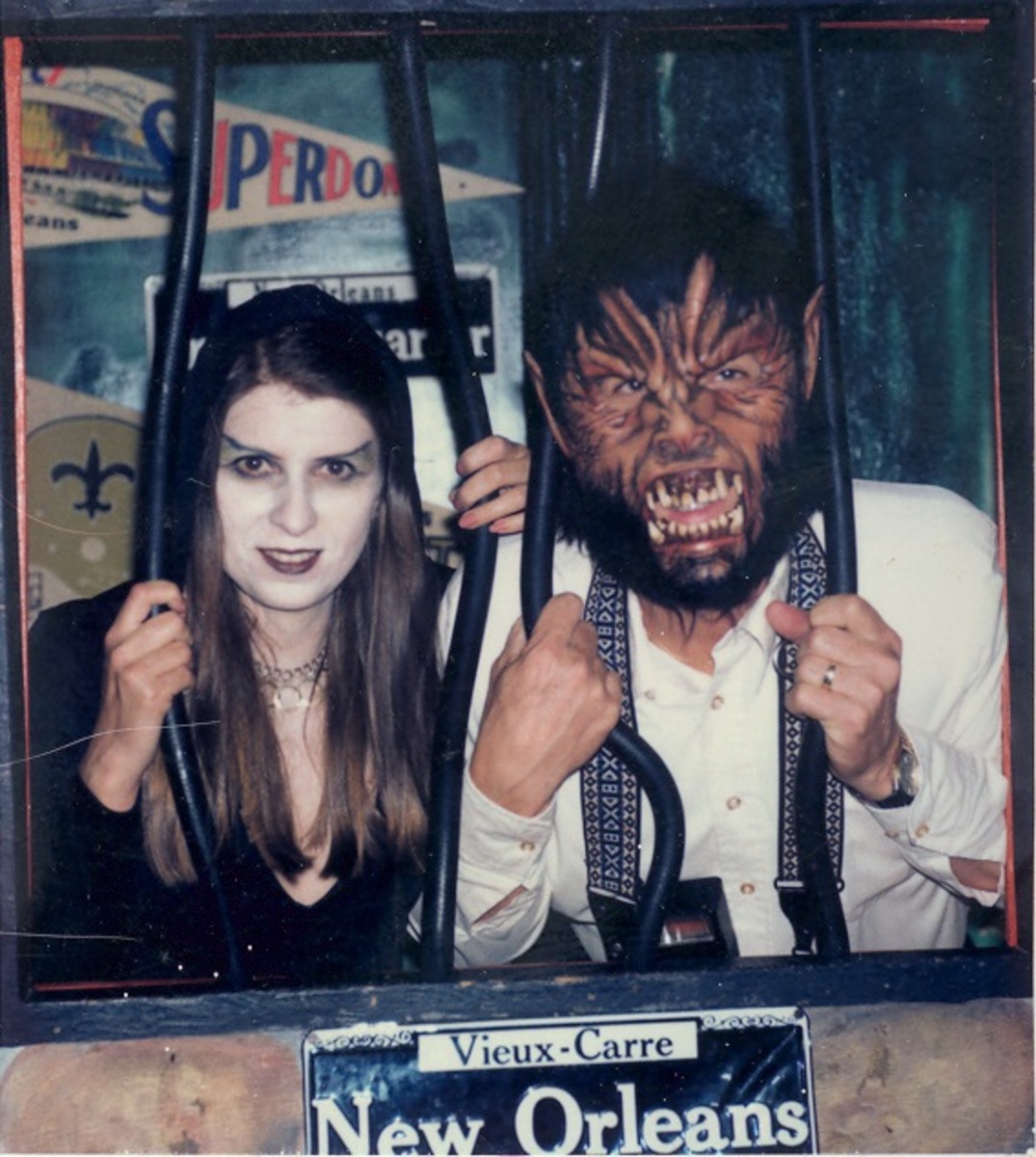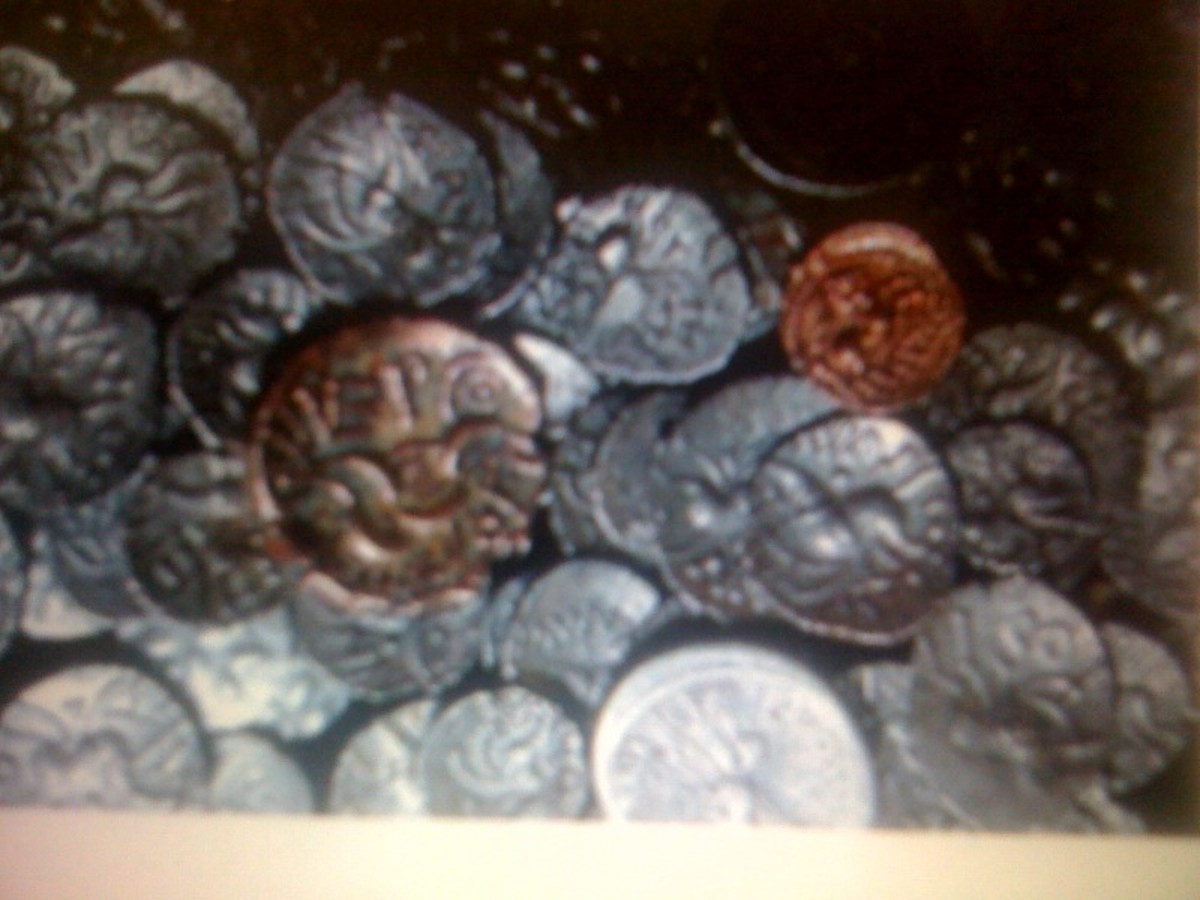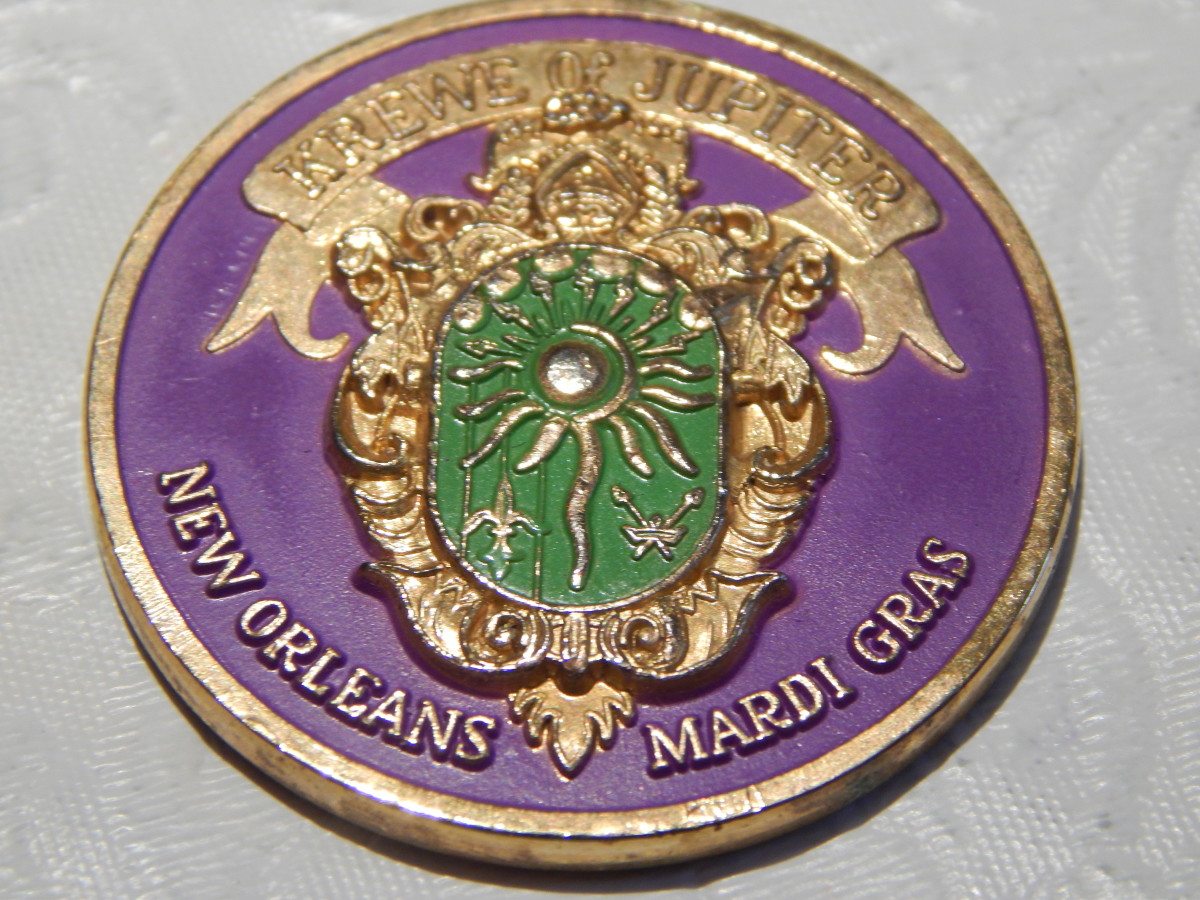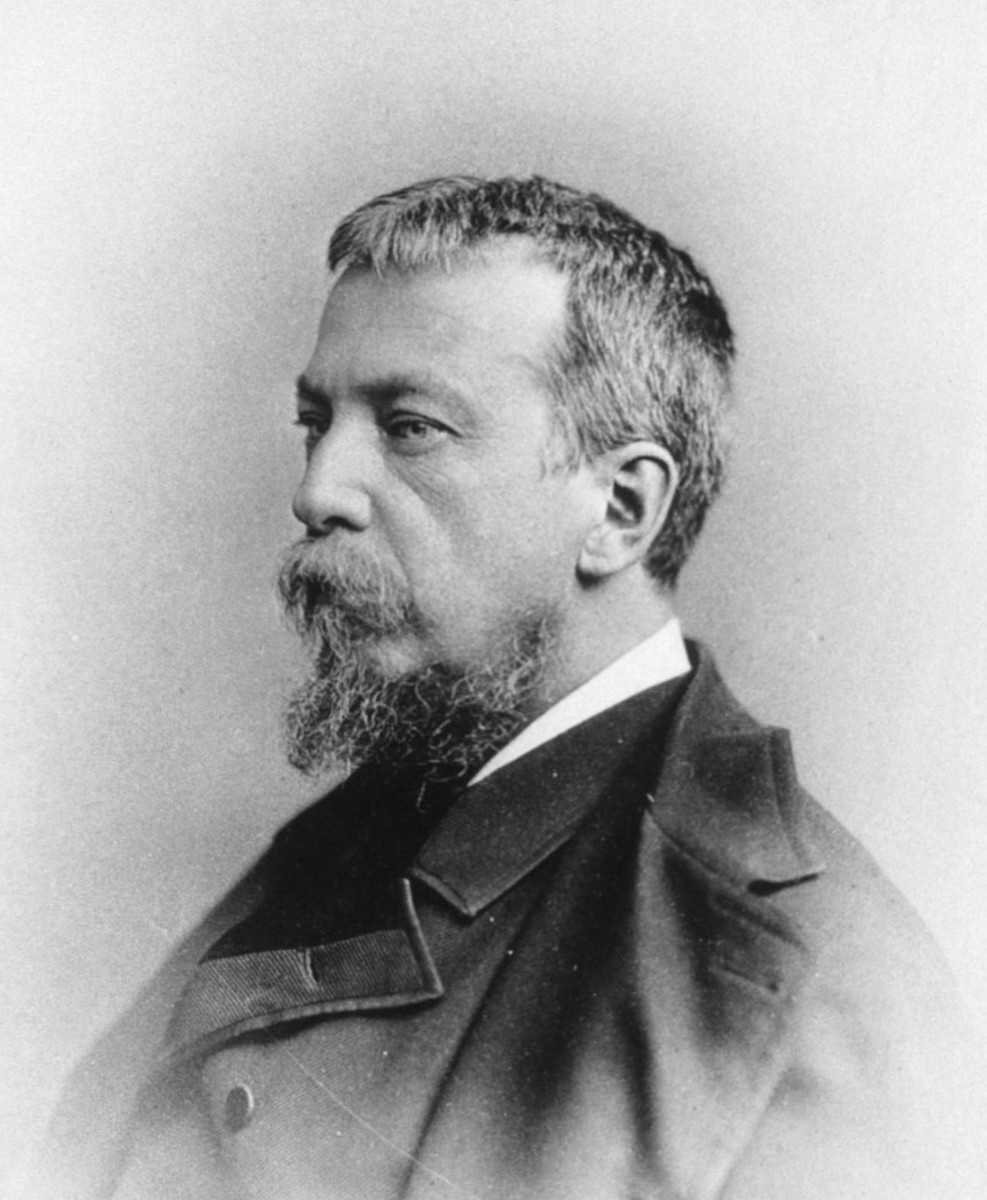New Orleans
New Orleans One Of The Best Places On Earth
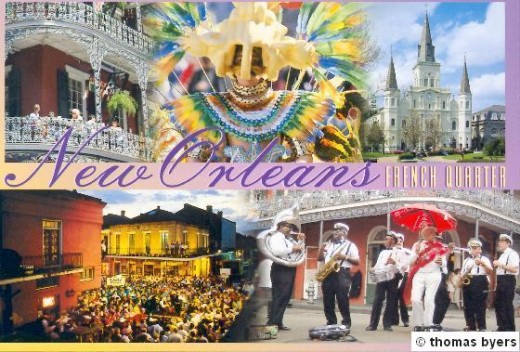
New Orleans Founded 1718
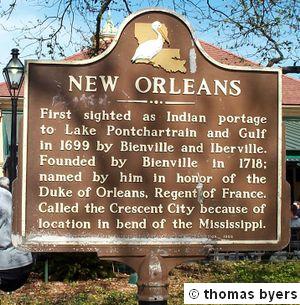
All About New Orleans
If you want to know about New Orleans , its ghosts , its food , its culture you have found the ultimate website for it. Here you will be able to find out everything you ever wanted to know about New Orleans plus you can even use this site to plan your New Orleans vacation. We hope you will come on down for some great New Orleans food , entertainment and fun.
Be sure you read below about the French Quarter. A very special part of New Orleans. A walk in the quarter after dark after a thunderstorm or just before is one of the best experiences in life. As is setting atop one of the levys and watching the Mississippi River and the ships on it some headed up river and some down. It makes you think about the history and if you ever visit New Orleans you will for certain want to take a trip up or down the river on a paddle wheeler and just for a bit you will be transformed back to the olden days when this was one of the main forms of travel in the area.
New Orleans, Louisiana Totally Explained
Hauntings
Click Here To See Our Page On Hauntings and Real Ghost Videos
This short attempts a non-biased look at post Katrina New Orleans by interviewing a diverse group of New Orleanians over one weekend. The film expresses the fru
New Orleans King Cake
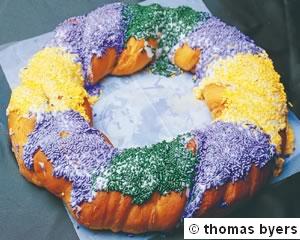
King Cakes , A Lafayette LA bakery makes the Mardi Gras treats.
New Orleans King Cake
The Complete History Of The New Orleans King Cake
A king cake (sometimes rendered as kingcake) is a type of cake associated with Carnival traditions. It is popular in Carnival season in the area of the United States which celebrates Carnival ranging from Mobile, Alabama to East Texas, but most of all New Orleans.
The cakes have a small trinket (usually a small plastic baby) inside, and the person whogets the piece of cake with the trinket has various privileges and obligations. And sometimes the person who gets the little trinket wins a great prize. Often also the person who gets the trinket is obligated to host the King Cake Party Next Year.
The king cake of the New Orleans Mardi Gras tradition comes in a number of styles. The most simple, said to be the most traditional, is a ring of twisted bread similar to that used in brioche, topped with icing or sugar, usually coloured purple, green, and gold (the traditional Carnival colors) with food colouring. Some varieties have filling inside, the most common being cream cheese followed by praline. Famous bakeries of the king cake are Antoine's, Gambino's, Haydel, and Randazzo, who feature original recipes and types of king cakes.
The "king cake" takes its name from the Biblical three kings. Catholic tradition states that their journey to Bethlehem took twelve days (the Twelve Days of Christmas), and that they arrived to honor the Christ child on Epiphany. The season for king cake extends from the end of the Twelve Days of Christmas (Twelfth Night and Epiphany Day), through to Mardi Gras day. Some organizations or groups of friends may have "king cake parties" every week through the Carnival season.
The traditional trinket in the cake is a bean, still seen in some European traditions but rare in U.S. king cakes. It is echoed, however, in some krewes' use of a gilded bean trinket.
Since the 1950s, the most common trinket has been a small plastic baby. Many people say this represents the baby Jesus, tied in to the connection with Epiphany. Many people attach no particular religious significance to the cake or trinket. The "baby in the king cake" was said to have become common after a local bakery chain got a large shipment of such plastic baby dolls from Hong Kong very cheaply in the 1950s, and some people say there is little further significance to the baby, but earlier ceramic baby dolls as trinkets are documented in New Orleans back to at least the 1930s. Running a distant second to babies, a trinket representing a king wearing a crown is the next most common design of trinket. Trinkets in the form of other figures have also been seen historically, and starting in the 1990s again became more common in the more expensive "gourmet" varieties of king cake. The common plastic baby of today is usually colored pink, brown, white or gold. Due to the choking hazard posed by small trinkets, some bakeries opt to include the "plastic baby" separately from the pastry. The plastic babies are most often found separately in cakes from stores not native to New Orleans such as Sav-A-Center, whereas local bakeries are more likely to sell cakes with babies already inside. Usually when kingcakes are ordered to be shipped out of New Orleans the cake and trinket are packaged separately so that the plastic baby will not pose a choking threat to kingcake novices.
It is common for New Orleanian children to collect kingcake babies and play with them alongside the rest of their dolls and toys.
Privileges and obligations associated with the trinket
The person who gets the trinket is declared king or queen of the party, sometimes given a paper, plastic, or costume jewelry crown or tiara. Sometimes there are separate cakes to select the male and female royalty; the one for women is sometimes called a queen cake. The monarch is usually obligated to supply the next king cake or host the next party or both. King cake parties may be held at the homes of people who live on or near the routes of Carnival parades.
It is a common practice in elementary schools to have King cake parties, usually on a Friday. The person who gets the trinket is required to bring the cake the following week.
In some office work places, a variation on this tradition is simplified so that workers share a king cake at lunch or during the day, with the person getting the trinket having to bring the cake for the next work day, with no other ceremony.
Some krewes select their monarchs via king cake.
What Is A Krewe
A Krewe (pronounced identically to English "crew") is an organization that puts on a parade and or a ball for the Carnival season. The term is best known for its association with New Orleans Mardi Gras, but is also used in other Carnival celebrations around the Gulf of Mexico Coast, such as the Gasparilla Pirate Festival in Tampa, Florida, and Springtime Tallahassee.The word is thought to have been coined in the early 19th century by an organization calling themselves Ye Mystick Krewe of Comus, as an imitation or parody of Old English; with time it became the most common term for a New Orleans Carnival organization.Krewe members are assessed fees in order to pay for the parade and/or ball. Fees can range from thousands of dollars a year per person for the most elaborate parades to as little as $20 a year for smaller marching clubs. Criteria for krewe membership varies similarly, ranging from exclusive organizations largely limited to relatives of previous members to other organizations open to anyone able to pay the membership fee. Krewes with low membership fees may also require members to work to help build and decorate the parade floats and make their own costumes; higher priced krewes hire professionals to do this work. Parading krewe members are usually additionally responsible for buying their own throws, the trinkets thrown to parade spectators according to New Orleans tradition.Some Krewes also have other events like private dances or parties for members throughout the year. Some also make a point of supporting charities and good causes.
Mardi Gras in New Orleans , If you've never been plan a trip
Mardi Gras in New Orleans
Q. What's Mardi Gras about?
A. Mardi Gras is New Orleans' most famous and biggest holiday season. New Orleans and Mardi Gras are so linked in public perception that it sometimes comes as a surprise that the holiday didn't originate here. But New Orleans and Mardi Gras have put their stamp on one another over the centuries, to the extent that there is some sense of the spirit of Mardi Gras year-round, reflected in every festival and party in the city.
First, some definitions. The proper name for the holiday season that begins on Jan. 6 (or Twelfth Night) every year and ends on the day before the beginning of Lent is "Carnival."
Technically the name "Mardi Gras" applies only to Fat Tuesday (the English translation of the French name), the day before Ash Wednesday, the beginning of Lent. In New Orleans and elsewhere, however, it is common to use the term Mardi Gras to describe the festivities of the entire season, much as we might say "Merry Christmas," or "It's Christmas-time" to describe the entire period between Thanksgiving and Dec. 25. So when the krewe of the Phunny Phorty Phellows holds the official kickoff event of the Carnival season on Twelfth Night, their toast is "It's Mardi Gras! Happy Mardi Gras 2004."
The entire Mardi Gras season is filled with balls, parties and a gradual buildup of parades, first in the outlying areas, then finally in a ten-day procession of giant parades drawing hundreds of thousands of people in New Orleans. It is this final parade season, which this year begins Feb. 13 and goes through Mardi Gras Day, Feb. 24, that is the image most people see when they think of "Mardi Gras.
Parades are paid for and put on by private organizations generally called "krewes." Amazingly to some, there is no central committee or organization for Mardi Gras . . . no "official" anything . . . the world's biggest party is a conglomeration of events sponsored and paid for by dozens of private and independent organizations. The only thing under official control is the parade permits, which must be approved by the city.
The name "Carnival" comes from the Latin phrase that means "farewell to the flesh," which can apply to both meat and human desires. This festival period, which has roots back into ancient Rome and perhaps earlier, was designated by the Catholic Church as a time of celebration and feasting before the beginning of Lent, a time of fasting and repentance in preparation for Easter. "Eat, drink and be merry, for tomorrow you diet." Traditionally the celebration ends at midnight on Fat Tuesday, and the next morning, parishioners attend Mass and receive the mark of ash on their foreheads to mark the beginning of Lent.
For visitors to New Orleans, Mardi Gras offers two main attractions: the world-class parades and the infamous partying that goes on around the parade schedule, especially in the French Quarter. Most other Carnival events - including most of the krewe's balls - are closed to the public.
Parades begin this year in New Orleans on Feb. 13, with numerous parades over the long weekend, then scattered during the week, then with multiple parades daily during the long five-day period leading up to Mardi Gras Day. The biggest and most famous "superkrewes" roll during this period, including the parade of Rex, King of Carnival, Zulu, Endymion, Orpheus and Bacchus. Some visitors prefer to come on the first weekend of the parade period, where crowds are smaller and more manageable . . . others want to experience the full blast of the final five days. In the French Quarter, street partying, which goes on every weekend around the year, grows daily until Mardi Gras night, when it's difficult to move around the district because of the massive crowds.
Mardi Gras in New Orleans
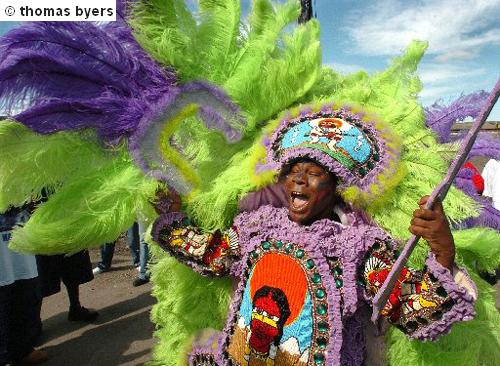
Mardi Gras in New Orleans
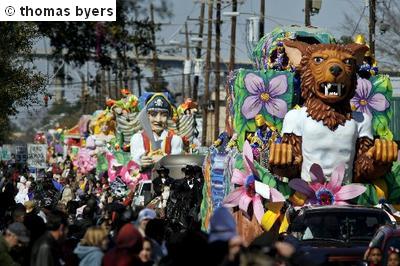
Mardi Gras in New Orleans
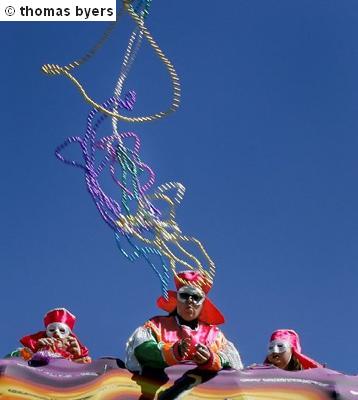
Mardi Gras in New Orleans
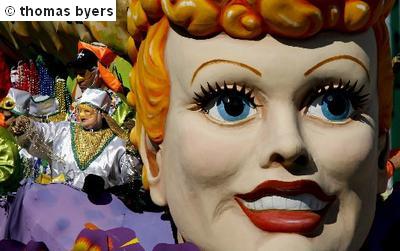
Mardi Gras in New Orleans
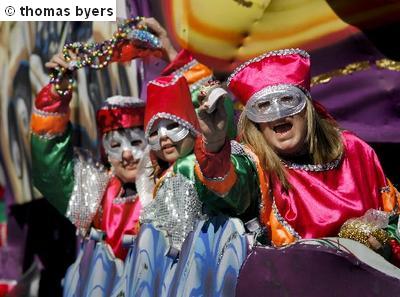
Mardi Gras in New Orleans
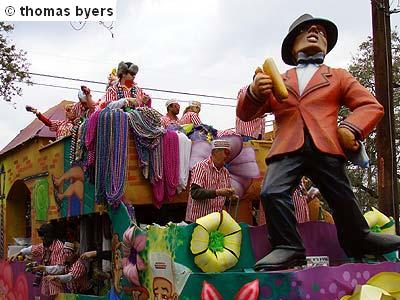
Mardi Gras in New Orleans
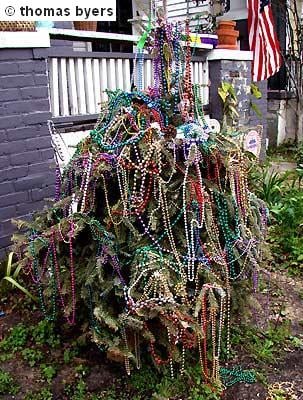
Mardi Gras in New Orleans
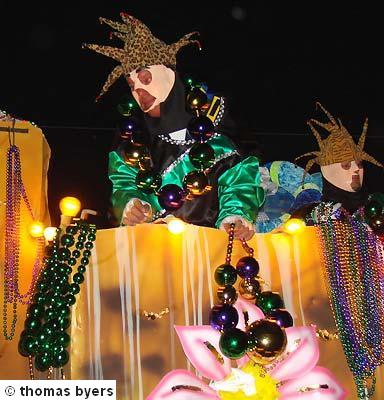
Mardi Gras in New Orleans
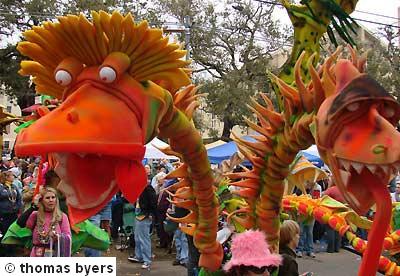
Mardi Gras in New Orleans

The Battle Of New Orleans
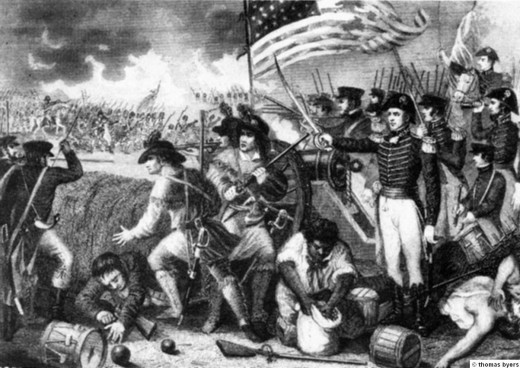
Battle Of New Orleans
The Battle Of New Orleans, also known as the Battle of Chalmette Plantation, took place on January 8, 1815, at the end of the War of 1812, when the American forces under General Andrew Jackson decisively defeated an invading British army intent on seizing New Orleans and control of the Mississippi River. Both nations had agreed to peace but the news had not reached Louisiana.
On December 13, 1814, a British fleet commanded by Vice Admiral Sir Alexander Cochrane arrived off the Louisiana coast with 14,000 men. In a brief but violent battle on Lake Borgne, 53 British rowing boats armed with bow-chasers overwhelmed five American dinghies protecting the waters.
A few days later, the British forces under Major General Sir Edward Michael Pakenham landed along the lower Mississippi River. At first, they met with only minor resistance. The Americans, led by Major General Andrew Jackson, set up defensive positions at Chalmette, Louisiana, some five miles (8 km) downriver from New Orleans. Jackson, because he needed time to get his artillery into position, decided to immediately attack the British. When Jackson learned that the British had taken the plantation he said, "Gentlemen, the British are below us, we fight them tonight.".
On the night of December 23, Jackson led a three-pronged attack on the British Army camp which lasted until early morning. After capturing some equipment and supplies, the Americans withdrew to New Orleans suffering a reported 24 killed, 115 wounded and 74 missing or captured, while the British claimed their losses as 46 killed, 167 wounded, and 64 missing or captured.
This stalled the British advance long enough for the Americans to bring in their heavy artillery and establish earthworks along a portion of the east bank of the Mississippi River. On Christmas Day, Pakenham arrived on the battlefield and ordered a reconnaissance-in-force against the American earthworks protecting the roads to New Orleans. On December 28, groups of British troops made probing attacks against the American earthworks.
When the British troops withdrew, the Americans began construction of artillery batteries to protect the earthworks which were then christened “Line Jackson”. The Americans installed eight batteries, which included one 32-pound gun, three 24-pounders, one 18-pounder, three 12-pounders, three 6-pounders and a 6-inch howitzer. Jackson also sent a detachment of men to the west bank of the Mississippi to man two 24-pounders and two 12-pounders from the grounded warship Louisiana.
The main British army arrived on New Year's Day, and attacked the earthworks using their artillery. An exchange of artillery fire began that lasted for three hours. Several of the American guns were destroyed or knocked out, including the 32-pounder, a 24-pounder and a 12-pounder, and some damage was done to the earthworks. While the Americans held their ground, the British guns ran out of ammunition, which led Pakenham to cancel the attack. Pakenham decided to wait for his entire force of over 8,000 men (a force that included Native American members of the Hitchiti tribe, led by Kinache, and several hundred black soldiers from the British West Indies colonies) to assemble before launching his attack.
In the early morning of January 8, Pakenham ordered a two pronged assault on the American position: one attacking the west flank across the Mississippi, and one directly against the main American line.
The attack began under a heavy fog, but as the British neared the main enemy line, the fog suddenly lifted, exposing them to withering artillery fire. The British, armed only with muskets effective at close range, tried to close the gap, but discovered that the ladders needed to cross a canal and scale the earthworks had been forgotten; it did not matter because the soldiers did not reach the canal. Most of the senior officers were killed or wounded, and the British infantry could do nothing but stand in the open and be mown down by a combination of musket fire and grapeshot from the Americans.
There were three large, direct assaults on the American positions, but all were repulsed. Pakenham was fatally wounded in the third attack, when he was hit by grapeshot on horseback while 500 yards from the earthworks. General John Lambert assumed command upon Pakenham's death and ordered a withdrawal.
At the main battle on January 8 the British suffered 2,037 casualties, (291 dead including the three senior generals, 1,262 wounded and 484 captured or missing). The Americans had 13 dead 39 wounded and 19 missing [1]. The only British success was on the west bank of the Mississippi River, where a 700-man detachment attacked and overwhelmed the American line. But when they saw the defeat and withdrawal of their main army on the east bank, they decided to withdraw also, taking some American prisoners and a few cannon with them.
United States forces at the time of the battle were between 3,500 and 4,500. This force was composed of U.S. Army troops (Tennessee, Kentucky, Mississippi, and Louisiana Militia), U.S. Marines, U.S. Navy sailors, Barataria Bay pirates, Choctaw Indian warriors, and free black soldiers. Major Gabriel Villeré commanded the Louisiana Militia, and Major Jean-Baptiste Plauché headed the New Orleans uniformed militia companies.
With the defeat of the British Army and the death of Pakenham, Lambert decided that despite reinforcements and the arrival of a siege train to besiege New Orleans, continuing the battle would be too costly. Within a week, all of the British troops had redeployed onto the ships and sailed away to Biloxi, Mississippi, where the fleet captured Fort Bowyer on February 12. The next day, news arrived of the peace treaty. Even though it had not been ratified the British realized the war was over and they sailed home.
Americans had believed that a vastly powerful British fleet and army sailed for New Orleans (Jackson himself thought 25,000 troops were coming), and most expected the worst. The news of victory, one man recalled, "came upon the country like a clap of thunder in the clear azure vault of the firmament, and traveled with electromagnetic velocity, throughout the confines of the land." (Ward p 4-5) The news turned a frustrating war into a triumph and created a surge of American nationalism. Andrew Jackson won the reputation that propelled him to the White House.
A federal park was established in 1907 to preserve the battlefield; today it features a monument and is part of Jean Lafitte National Historical Park and Preserve.
New Orleans Flea Market
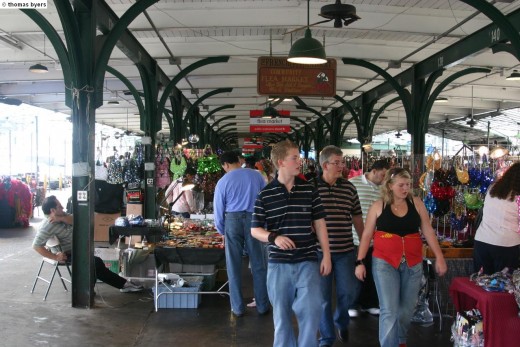
The New Orleans Flea Market In The French Quarter
New Orleans’ French Market has existed in this French Quarter site since 1791 and has remained true to its authentic mission for 200 years. It is America’s oldest public market and to this day plays an important role in the local economy.
Walk up and down the five blocks of specialty retail shops (a great place to find that one-of-a-kind souvenir for the folks back home) and a community flea market showcasing locally made jewelry, clothing and artifacts. Look for the local farmers selling the freshest fruits, vegetables and Creole herbs and spices. In the late spring and summer, bring home some succulent Creole tomatoes, a true delight!
Located on the edge of the market is Café du Monde, a world renowned outdoor restaurant featuring café au lait (piping hot coffee with steamed milk) and beignets (hot, square donuts topped with powdered sugar). There are casual restaurants for lighter fare and fine dining available at Bella Luna Restaurant, Tujaque’s and others.
Please note: many restaurants have public restrooms, but most reserve them for paying customers. Public restrooms are located in the outdoor community flea market and on Decatur Street at the French Market.
New Orleans Crayfish ,Shrimp and Oysters
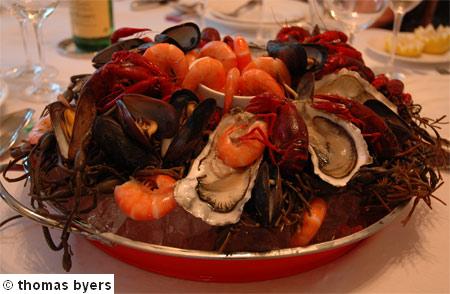
New Orleans Recipes
Here's a great selection of New Orleans Recipes. You will find here some of the greatest Cajun/New Orleans Recipes ever. Try them I guarantee you that you will love them.
New Orleans Gumbo
For shrimp and okra gumbo:
- 3 tablespoons of vegetable oil
- 3 tablespoons of flour
- l large chopped onion
- 1 cup chopped celery
- 5 or 6 cloves, chopped garlic
- 1 cup of chopped green pepper
- 1 can of tomato sauce
- 1 can of tomatoes ("Rotel" tomatoes for a spicier taste!)
- 1 pound, fresh sliced okra (or 2 boxes of frozen sliced okra)
- 2 pounds of fresh shrimp
- 2 - 3 cups water
- salt & pepper to taste
- 1 teaspoon of sugar
- 1 tablespoon of chopped parsley
- 1 bay leaf
- 1 small can of crabmeat or 3 fresh gumbo crabs
- 1 jar oysters
- Slowly stir the flour into heated oil in a heavy cast iron skillet. Continue to stir until the flour is dark brown. Add the next 4 ingredients; stir until onions are clear.
- Add tomato sauce. Stir until it gets crumbly or dry. Fry okra in another skillet until it is no longer sticky or stringy. Add tomatoes and fried okra.
- Cook slowly, adding 2 to 3 cups of water--a little at a time. Season with salt and pepper to taste. Stir in one teaspoon of sugar.
- Cook for about an hour on a low fire, stirring occasionally to prevent sticking to the bottom of pot; adding water if necessary. Add the shrimp and the bay leaf (and if desired, the oysters and crabmeat).
- Cook another 30 minutes to an hour, adding seasoning to taste.
- Serve over boiled or steamed rice.
Cooking Crawfish
How to boil crawfish Cajun style!
- Equiment needed: One large cooking pot with wire basket big enough to hold 25 pounds of Crawfish. A lid for the pot and a small outdoor propane cooker, as you will cook this outside.
- Go buy a six-pack of cold beer and drink the first one.
- Then go shopping for 25# sack of live Crawfish, 3 bags of crab boil, 1 small bottle of liquid crab boil, 3 round boxes of salt, 1 box square box of rock salt, 8 small onions, 8 small potatoes and 8 ears of corn, one fresh garlic, small can of cayenne pepper, 4 lemons, and a box of Tony Chachere's creole seasoning. Now that you're finished shopping, drink another beer.
- Now it's time to go to work cooking the Crawfish! One thing you must always remember about Crawfish....first separate the live Crawfish from the Crawfish that won't make it to the pot. Next you must purge the Crawfish. Get a large tub of water or two large ice chests. You will use this to purge the crawfish. Place the box of rock salt in the water. Stir the water with the salt and then place the Crawfish into the water. Let the Crawfish purge for 7 minutes. Remove the Crawfish and place in an ice chest until ready to cook. Time to drink another beer.
- Fill the pot with fresh water half full, place on cooker, and start the fire. Place a box and a half of salt into the water, 1 bag of crab boil, a half bottle of liquid crab boil, 2 teaspoons of cayenne pepper and two lemons cut in half--squeeze each half into the pot and drop the lemon. Separate the garlic into pods and cut the small ends of each garlic pod, then drop them into pot. Place lid on pot. Time to drink another beer.
- Let the water come to a boil for two minutes--that way the spices will mix well. Drop the 8 onions after cutting the ends--yes, drop the whole onion into the pot--4 minutes later, drop the 8 small potatoes; 4 minutes later, drop the 8 corns. Let it cook for five minutes. A good way to check for readiness is to take a fork or sharp knife and stab the potatoes and the onion. If it goes in easy, it is cooked. Lower the fire on the burner and remove the basket. Place the vegetable in a small clean ice chest--don't close the lid, just place foil on top. Place the basket back in the pot. Time to drink another beer.
- Turn the heat up on the burner, place the other two bags of crab boil in the pot, the rest of the liquid crab boil, and one large heaping teaspoon of cayenne pepper. Take the rest of the lemons cut in half, squeeze each half into the pot and drop the lemon. Place the last two boxes of salt into the water. When the water comes to a boil, place the Crawfish into the basket and place lid on top. Time for another beer. When the water comes back to a boil--you need to watch this part-- let it boil for 4 minutes, turn the fire off, let it simmer for 3 minutes, and remove.
- Now get an old table, and place old newspaper on top. Dump the basket of Crawfish on top of the newspaper, and sprinkle with Tony Chachere's creole seasoning. Dump the onions, potatoes, corn and garlic on top of the Crawfish. Now it's time to really drink beer and eat. You will love the vegetables, and you can cook them this way without having to cook Crawfish! Hope you pass a good time eating the Crawfish!
- I suggest that you make a sauce on the side using mayo, tomato ketchup, a little Worcestershire sauce, and little garlic power. Mix this to your liking. Use the sauce to dip your peeled Crawfish into if you desire.
Cajun Rice And Seafood
1/2 lb margarine
3 cups onion, chopped very fine.
2 cups bell pepper, chopped very fine.
1/4 cup celery, diced up in small pieces.
1/4 cup all-purpose flour ( this is plain not self rising )
1 pint half and half
8 ounces sour cream ( Don't use lowfat )
1/4 cubes processed cheese
1-1/2 pounds cleaned fresh raw shrimp
1 pound fresh crabmeat (lump meat) ( Be sure to check for shell fragments)
One 6-ounce jar mushroom pieces
1 Small jar red diced pimentos
3 cups rice, cooked
Season to taste with red pepper flakes, black pepper, salt, garlic powder, and Hot Sauce
Melt butter in a 6 quart sauce pot. Sauté onions, bell pepper and celery on medium heat 5 minutes or until all is thoroughly softened. Add flour; stir in well. Add half and half, sour cream, cubed processed cheese and seasoning. Cook until all cheese is melted. Add shrimp, crab meat and mushrooms. Cook on medium heat 20 minutes, or until shrimp and crab meat are well-cooked. Add pimentos for color. Fold cooked rice into seafood sauce. This is really pretty served in dishes that look like real sea shells. You can usually find these dishes at Walmart. And it will really bring atmosphere to the meal.
Crab Cakes
Ingredients:
- 2 Tbl. Butter
- 2 Tbl. diced Onion
- 1/2 cup Bread Crumbs
- 2 beaten Eggs
- 1/2 cup Milk
- 2 cups cooked, Flaked Crab
- 1/3 cup diced Celery
- 1/2 tsp. Mustard
- 1 tsp. Lemon Juice
- 2 Tbl. chopped Parsley
- 1/2 tsp. Salt
- 1/2 tsp. Paprika
- 2 Tbl. Olive Oil
- 1 cup Flour
- Melt butter in saucepan and sauté onion and bread crumbs over medium heat for 2 - 3 minutes.
- Combine with all ingredients except olive oil and flour; chill for at least 2 hours.
- Shape into 8 cakes, dust with the flour.
- Fry them in olive oil for about 8 minutes over medium heat until brown, turning once.
Cooking Instructions
Cajun Cabbage
Serve with sausages or chops for a complete meal.
Ingredients:
- 4 cups coursely shredded cabbage (1 litre)
- 1 small onion, chopped
- 1 can (540ml/19oz) tomatoes
- 1 clove garlic,minced
- 1/2 tsp salt (2 ml)
- 1/4 tsp dried oragano (1 ml)
- 1/4 tsp pepper (1 ml)
- 1/4 tsp hot pepper sauce (1 ml)
- 1/2 cup frozen kernel corn (125 ml)
- 1/2 cup frozen cut green beans (1125 ml)
Cooking Instructions:
- In a large pot combine cabbage, onion, tomatoes, garlic, salt, oregano, pepper and hot pepper sauce.
- Cover and cook over medium low heat for 20 minutes or until cabbage is tender, stirring occasionally.
- Add corn and beans
- Cover and cook for 5 minutes or until heated through.
- Makes 4 servings
Shrimp & Andouille Sausage Gumbo
Yields 8 ServingsIngredients:
- 1/2 Cup Vegetable Oil
- 1/2 Cup All-Purpose Flour
- 4 Stalks Celery, chopped coarse
- 2 Medium Onions, chopped coarse
- 2 Green Bell Peppers; seeded, cored & chopped
- 2 Bay Leaves
- 2 tsp Salt
- 2 tsp Dried Oregano, crumble
- 1/2 tsp Cayenne
- 40 oz Clam Juice
- 28 oz Canned Plum Tomatoes, drained & chopped
- 1 lb Smoked Andouille Sausage, halved lengthwise & cut into 1/4" slices
- 1/2 lb Okra, trimmed & cut crosswise into 1/4" slices
- 2 lb Uncooked Medium Shrimp, peeled & de-veined
- Cooked Long Grain Rice
- 2 Tomatoes, seeded & diced
Cooking Instructions
- Heat the oil in a large Dutch oven over high heat until it is almost smoking.
- Add the flour and cook, stirring, until dark reddish brown (about 8 minutes).
- Add the celery, onions and bell peppers at once.
- Cook 5 minutes, stirring and scraping the bottom of the pan.
- Mix in the bay leaves, salt, oregano and cayenne.
- Add the clam juice, canned plum tomatoes and sausage.
- Boil 15 minutes.
- Add the okra.
- Reduce heat.
- Simmer until the okra is tender (about 15 minutes).
- Add the shrimp.
- Simmer until just cooked through (about 3 minutes).
- Mound rice in each soup bowl.
- Ladle the gumbo over.
- Serve sprinkled with diced tomato.
New Orleans Times Picayune
Want A Low Priced Flight To New Orleans
Don't Want To Fly. Take Greyhound
And if you don't want to fly there is always Greyhound. And if your really interested in some cheap travel and you get to see the country check out Greyhounds North America Discovery passes for 7 , 15 , 30 or 60 days. Fares are very resonable and you can buy a pass for any amount of those days and during that time you can travel all you want by Greyhound. Click Here To Check It All Out Now






